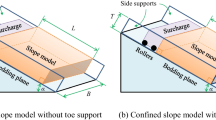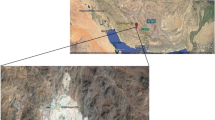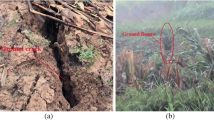Abstract
A stability analysis of a laterally confined slope model, lying on an inclined bedding plane, was presented to evaluate the lateral shear resistance by considering the loading paths and failure envelopes. Two slope models were prepared on a bedding plane by compaction, one with and one without lateral confinement. The compacted models are related to the geological conditions at shallow depths where brittle deformation can occur and an excavation can induce horizontal field stress that significantly influences the stability of the slope. Three distinct loading paths, controlled by either tilting the angles or increasing the surcharge loads, were applied to achieve the failure of the slope models. Rankine’s passive earth pressure due to compaction was reduced by the shear strength reduction ratio. The shear strength reduction ratio was estimated through the least-squares fitting method based on the results of model tests at failure when the loading paths intersected the failure envelope. Provided that the effect of lateral confinement in a rock mass can be described by the shear strength reduction ratio, the proposed equations will be beneficial for slope stability analyses of laterally confined slopes on bedding planes. A case study of an undercut pit wall in an open-pit mine was demonstrated by showing that the unknown shear strength reduction ratio can be back-analyzed from the rainfall-induced landslide case. Therefore, the design of other undercut slopes with different geometries and groundwater conditions in the rock mass, which have undergone the same geological process as the back-analyzed case, is possible.

















Similar content being viewed by others
Availability of data and material
Not applicable.
Code availability
Not applicable.
References
Brideau M-A, Stead D (2012) Evaluating kinematic controls on planar translational slope failure mechanisms using three-dimensional distinct element modelling. Geotech Geol Eng 30(4):991–1011. https://doi.org/10.1007/s10706-012-9522-5
Chen TJ, Fang YS (2008) Earth pressure due to vibratory compaction. J Geotech Geoenviron Eng 134(4):437–444. https://doi.org/10.1061/(Asce)1090-0241(2008)134:4(437)
Craig RF (2004) Craig’s Soil Mechanics. 7th edn. CRC Press. https://doi.org/10.4324/9780203494103
Dawson EM, Roth WH, Drescher A (1999) Slope stability analysis by strength reduction. Geotechnique 49(6):835–840. https://doi.org/10.1680/geot.1999.49.6.835
Duncan JM, Seed RB (1986) Compaction-induced earth pressures under K0-conditions. J Geotech Eng 112(1):1–22. https://doi.org/10.1061/(ASCE)0733-9410(1986)112:1(1)
Duncan JM, Williams GW, Sehn AL, Seed RB (1991) Estimation earth pressures due to compaction. J Geotech Eng 117(12):1833–1847. https://doi.org/10.1061/(ASCE)0733-9410(1991)117:12(1833)
Fredlund DG, Rahardjo H (1993) Soil mechanics for unsaturated soils. Wiley, New York
He C, Hu X, Tannant DD, Tan F, Zhang Y, Zhang H (2018) Response of a landslide to reservoir impoundment in model tests. Eng Geol 247:84–93. https://doi.org/10.1016/j.enggeo.2018.10.021
Hu X, Zhou C, Xu C, Liu D, Wu S, Li L (2019) Model tests of the response of landslide-stabilizing piles to piles with different stiffness. Landslides 16(11):2187–2200. https://doi.org/10.1007/s10346-019-01233-4
Izawa J, Kuwano J (2010) Centrifuge modelling of geogrid reinforced soil walls subjected to pseudo-static loading. Int J Phys Model Geotechn 10(1):1–18. https://doi.org/10.1680/ijpmg.2010.10.1.1
Khosravi MH, Pipatpongsa T, Takahashi A, Takemura J (2011) Arch action over an excavated pit in a stable scarp investigated by physical model tests. Soils Found 51(4):723–735. https://doi.org/10.3208/sandf.51.723
Khosravi MH, Takemura J, Pipatpongsa T, Amini M (2016) In-flight excavation of slopes with potential failure planes. J Geotech Geoenviron Eng 142(5):06016001. https://doi.org/10.1061/(asce)gt.1943-5606.0001439
Khosravi MH, Tang L, Pipatpongsa T, Takemura J, Doncommul P (2012) Performance of counterweight balance on stability of undercut slope evaluated by physical modeling. Int J Geotech Eng 6(2):193–205. https://doi.org/10.3328/ijge.2012.06.02.193-205
Leelasukseree C, Pipatpongsa T, Chaiwan A, Mungpayabal N (2021) Practical design, numerical analysis and site monitoring for huge arching effect during massive excavation of undercut slope in open-pit mine. Int J Geoeng Case His 7(1):22–57. https://doi.org/10.4417/IJGCH-07-01-02
Li L-q, Ju N-p, Guo Y-x (2017) Effectiveness of fiber bragg grating monitoring in the centrifugal model test of soil slope under rainfall conditions. J Mt Sci 14(5):936–947. https://doi.org/10.1007/s11629-016-4163-4
Li C, Wu J, Tang H, Hu X, Liu X, Wang C, Liu T, Zhang Y (2016) Model testing of the response of stabilizing piles in landslides with upper hard and lower weak bedrock. Eng Geol 204:65–76. https://doi.org/10.1016/j.enggeo.2016.02.002
Liu D, Hu X, Zhou C, Li L, He C, Sun T (2020) Model test study of a landslide stabilized with piles and evolutionary stage identification based on thermal infrared temperature analysis. Landslides 17(6):1393–1404. https://doi.org/10.1007/s10346-020-01355-0
Matsui T, San K-C (1992) Finite element slope stability analysis by shear strength reduction technique. Soils Found 32(1):59–70. https://doi.org/10.3208/sandf1972.32.59
Mungpayabal N (2005) Residual shear strength of sheared Green Clay in Mae Moh mine. Chiang Mai University, Thailand, Thesis
Nakamoto S, Iwasa N, Takemura J (2018) Centrifuge modelling of rock bolts with facing plates. Int J Phys Model Geotech 18(1):21–32. https://doi.org/10.1680/jphmg.16.00006
Pipatpongsa T, Khosravi MH, Takemura J (2013) Physical modeling of arch action in undercut slopes with actual engineering practice to Mae Moh open-pit mine of Thailand. In: The 18th international conference on soil mechanics and geotechnical engineering (ICSMGE18), Paris, France, 2013. pp 943–946
Pipatpongsa T, Khosravi MH, Takemura J, Leelasukseree C, Doncommul P (2016) Modelling concepts of passive arch action in undercut slopes. In: Dight P (ed) The first Asia Pacific slope stability in mining conference, Brisbane, Australia, 2016. Aus Centre Geomech 507–520
Souloumiac P, Maillot B, Leroy YM (2012) Bias due to side wall friction in sand box experiments. J Struct Geol 35:90–101. https://doi.org/10.1016/j.jsg.2011.11.002
Standards JGS (2015) Laboratory testing standards of geomaterials JGS 0561 method for consolidated constant-pressure direct box shear test on soils
Taylor RN (1994) Geotechnical Centrifuge Technology. CRC Press
Ukritchon B, Ouch R, Pipatpongsa T, Khosravi MH (2017) Experimental studies of floor slip tests on soil blocks reinforced by brittle shear pins. Int J Geotechn Eng 1–8. https://doi.org/10.1080/19386362.2017.1314126
Wang Y, Zhang G, Wang A (2018) Block reinforcement behavior and mechanism of soil slopes. Acta Geotech 13(5):1155–1170. https://doi.org/10.1007/s11440-018-0644-7
Zhang G, Li M, Wang L (2014) Analysis of the effect of the loading path on the failure behaviour of slopes. KSCE J Civ Eng 18(7):2080–2084. https://doi.org/10.1007/s12205-014-1461-7
Acknowledgements
Thanks are offered to Mr. Takeshi Kano, a former graduate student, Department of Urban Management, Kyoto University, for his assistance with the experiments. Appreciation is also extended to Mr. Jitti Trirat, Head of the Slope Monitoring Section, Geotechnical Department, Mae Moh Mine Planning and Management Division, Electricity Generating Authority of Thailand, for his critical comments on the monitoring data.
Funding
This research was financially supported by the Electricity Generating Authority of Thailand (EGAT).
Author information
Authors and Affiliations
Contributions
Conceptualization: Thirapong Pipatpongsa; methodology: Kun Fang; formal analysis and investigation: Thirapong Pipatpongsa and Apipat Chaiwan; validation Kun Fang; visualization Thirapong Pipatpongsa, Kun Fang, Cheowchan Leelasukseree, and Apipat Chaiwan; writing — original draft preparation: Thirapong Pipatpongsa and Kun Fang; writing — review and editing: Kun Fang and Cheowchan Leelasukseree; funding acquisition: Cheowchan Leelasukseree; resources: Apipat Chaiwan; supervision: Thirapong Pipatpongsa.
Corresponding author
Ethics declarations
Conflict of interest
The authors declare no competing interests.
Appendices
Appendix 1
The substitution of FN, expressed in Eq. (2) into Eq. (1) yields
The substitution of pL, expressed in Eq. (7) into Eq. (16) yields
The substitution of Eqs. (30) and (31) into Eq. (17) yields
The substitution of FS = 1, Eq. (3), and Eq. (32) into Eq. (18), with a minor arrangement, leads to the following equation:
Hence, ΔW/γBLT is formulated from Eq. (33) as follows:
To formulate α, all terms related to α are arranged on the left side of Eq. (33) and rearranged to the equation below:
where
Multiplying cosβ on both sides of Eq. (35) leads to the following equation, using Eq. (36):
where
Hence, α is formulated as follows:
Appendix 2
Regarding Rankine’s earth pressure theory, effective horizontal stress σ′h varies with effective vertical stress σ′v and is limited by the active earth pressure and the passive earth pressure expressed in Eqs. (43) and (44), respectively.
The transition of σ′h from active earth pressure to passive earth pressure can generally be associated with shear strength reduction ratio rd and coefficient of lateral earth pressure K through Eqs. (45) and (46).
where
The range in rd is from − 1 to 1. Consequently, the effective horizontal stress is in the active state when rd < 0, isotropic when rd = 0, and in the passive state when rd > 0. In regards to Eq. (46), rd can be formulated to the following equation:
With the substitution of Eq. (47) into Eq. (45), K can be solved as follows:
The removal of K from Eq. (47) can be achieved by substituting Eq. (48) into Eq. (47). Hence, rd can be calculated by Eq. (49), using material parameters c and ϕ as well as σ′v and σ′h measured at the same depth.
Moreover, if both c and ϕ are kept unchanged with depth, rd could be determined from the changes in effective vertical stress Δσ′v and horizontal stress Δσ′h by considering the increment in Eq. (45), as follows:
The removal of K from Eq. (50) can be achieved by using Eq. (47) and leads to the following equation:
Concerning Eq. (51), rd can be solved as shown in Eq. (52) in terms of ϕ and the ratio of Δσ′v/σ′h obtained at two different depths.
Rights and permissions
About this article
Cite this article
Pipatpongsa, T., Fang, K., Leelasukseree, C. et al. Stability analysis of laterally confined slope lying on inclined bedding plane. Landslides 19, 1861–1879 (2022). https://doi.org/10.1007/s10346-022-01873-z
Received:
Accepted:
Published:
Issue Date:
DOI: https://doi.org/10.1007/s10346-022-01873-z




